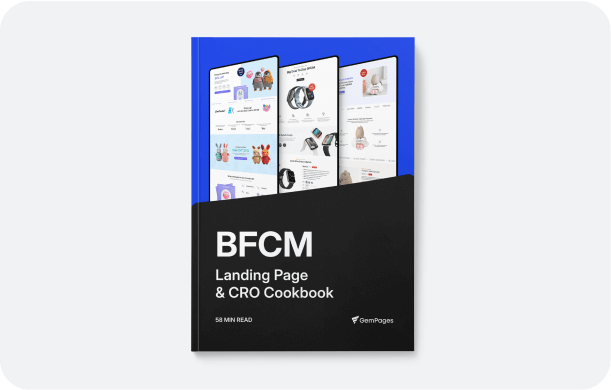Shopify in Italy: Everything You Need to Know

Italy is known for its dreamy tourist attractions and universally loved traditional dishes, but did you know this country is becoming a hotbed for digital innovation as well? Italian entrepreneurs are avid members of the eCommerce scene, where Shopify is crowned as a prominent influence for many success stories. In this blog post, prepare for a deep dive into Shopify in Italy, including the current eCommerce landscape, how to set up a website that converts, as well as our top picks for the most impressive stores on this platform. Without further ado, let’s dive in.
An Overview of the eCommerce Landscape in Italy

Italy has adopted eCommerce as a commonplace shopping platform due to its convenience.
In order to go into details, let’s first take a step back and look at the big picture: is Italy a thriving market for eCommerce?
To give you a short answer, the eCommerce landscape in Italy has constantly grown at a steady rate in the past years, so it is safe to say that this nation is one of the most bustling hubs for eCommerce hustlers to take advantage of. Its geographical location and stance in the EU also grant Italy-based merchants the privilege of doing business across Europe without many hindrances. All in all, this market is an excellent choice for online sellers who are looking to expand their customer base.
If words alone are not convincing, here are some statistics about the eCommerce landscape in Italy:
- The eCommerce market is estimated at $101.88 billion and is expected to grow to $163.66 billion by 2029.
- Mobile commerce accounts for over a third of online orders, which amounted to $7 million in sales.
- 47.1% of Italian consumers shop online weekly.
- The digital eCommerce revenue increased by 13% in the third quarter of 2024.
Is Shopify a Good Choice for the Italian Market?

Shopify has proven to be a local favorite when it comes to the Italian market.
When it comes to online shopping in general, it is not hard to notice that a considerable number of businesses have chosen Shopify as their home base. From the viral makeup brand Kylie Cosmetics to the worldwide famous Oreo cookie, more and more brands are partnering up with this versatile platform. Whether you are a seasoned merchant or just made an entrance into the industry yesterday, Shopify is guaranteed to have what you need to kickstart your business venture.
For the Italian market, it comes as no surprise that Shopify also stands shoulder to shoulder with other major eCommerce host platforms. Its multi-language and -currency functionality appeal to the European region, while the seamless mobile integration, localized features, and various payment gateways have proven to be incredibly sufficient among Italian shoppers. No matter what your starting budget is, starting with Shopify is a hassle-free procedure.
How to Set Up a Shopify Store in Italy
Step 1: Sign up for Shopify and pick a pricing plan
Sign up for a Shopify account and pick the most suitable plan for your needs. The available plans stand at $25, $65, $399, or $2,300 per month. Shopify also has a 14-day free trial, as well as a $1 for your first-month deal on the first three plans.
Tip: After creating an account, you will be asked to name your store. Since your target market is Italy, make sure to choose a store name that resonates with your audience and is not a duplicate of existing businesses.
More details about the plans here: Shopify Pricing.
Step 2: Select and customize a theme for your store
If you are searching for a theme that perfectly captures your brand’s mission, look no further than the Shopify Themes Store. It is a goldmine with a multitude of free and paid themes with functional and intuitive features, all come with an easy-as-pie setup. To know which type of theme works best with your business, make sure to conduct a thorough assessment of your brand identity, desired look, and functions, as well as estimated spending to get the most ideal headstart.
A third-party page builder like GemPages could be a game-changer for your business, as advanced functions are available at your fingertips. Check out our 200+ CRO templates to get started.
Tip: keep tabs on multilingual themes with Italian as a language option.
More from us:
Emerging Trends in eCommerce: The Best Shopify Themes to Dominate in 2025
The Best Shopify Themes for SEO Success (2024)
Step 3: Configure the languages and currencies
Language and currency integrations are vital every time you enter a new market. For Italy, be sure to make your store accessible in Italian - the country’s official language and to set the default currency to Euro (EUR).
Regarding payment gateways, Italian stores in Shopify can accept Visa, Mastercard, Maestro, American Express, Union Pay debit and credit cards, as well as Apple Pay, Google Pay, and Shop Pay. For more information about additional fees and requirements, go to Shopify Payments in Italy.
Tip: Add language and currency switches on your site to appeal to international shoppers.
Step 4: Add your products and set up pricing
To add products, go to Shopify Admin > Products > Add product. Enter all the required information like product titles, descriptions, images, and prices. If possible, create compelling product descriptions in Italian to connect with local shoppers.
Tip: This is also the time to develop an efficient pricing strategy. Studying your competitors first is a good call to maximize your profit margin.
Step 5: Offer clear shipping information
In order to assemble a competent shipping system, making yourself familiar with the local shipping carriers in Italy is the key. Some popular shipping services are Poste Italiane, DHL, GLS, and FedEx. These options are highly regarded among eCommerce sellers in this country.
Once you have an idea of potential shipping partners, begin building up a comprehensive yet straightforward shipping information webpage for customers. Remember to touch on the shipping rates, extra fees, estimated delivery times, tracking options, and so on. All these details can be added in Shopify Admin > Settings > Shipping and Delivery.
Tip: Offer free or discounted shipping to create a positive brand’s first impression.
Step 6: Localize your store
Localization encompasses a merchant’s ability to assimilate into a new market. As a result, this goes beyond changing the language and currency of your store. To have a full grasp of what to keep or omit, go to Italy-based eCommerce stores and take note of their aesthetics, website designs, and language usage. Other details such as product preferences, local terminology, and customer support all need to be taken into account to ensure a smooth business operation.
Tip: If needed, consult a local specialist to help you pinpoint their cultural exclusivities.
Step 7: Market your business
There are several ways to market your business, and with the nature of eCommerce, it is nothing short of simple to get the wheels moving. The most common marketing tactics are targeted ads, social media engagement, email marketing, and content marketing. That said, every country has its own unique consumer behavior, which is evident in its most used social media platform or shopping habits. Thus, the success of this step is largely determined by the localization process mentioned above.
Tip: Cherry-picking the most suitable marketing strategy is more advisable than giving everything a try. This eliminates extra costs and time, while enabling you to focus on branding first before chasing after the latest trends.
5 Thriving Italian Shopify Businesses You Should Keep an Eye on
When in doubt, learn from the predecessors. All the stores in this list have two things in common: they are based in Italy, and they all have Shopify as their host platform.
Kappa

This worldwide famous sportswear brand managed to present a striking eCommerce store through the help of Shopify.
Kappa is known as a sportswear company with a history dating back to 1967. This Italian-born brand has opted for Shopify as a host platform for all things eCommerce, and now carries a wide array of apparel, accessories, and footwear. Its website checked all the boxes of how a digital storefront should look: recognizable logo, clear-cut navigation, user-friendly interface, and top-notch product images. This long-standing brand’s fruitful expansion to the eCommerce world is solid proof that the landscape is more than rewarding for businesses of all sizes, as long as you have the right resources.
Save The Duck

Save The Duck’s vision is to offer high-quality garments that do not harm the Earth and animals.
If you are in the apparel niche, Save The Duck is a great source of inspiration. Founded in 2012, the company has made a mark as a sustainable outerwear brand whose mission is to offer high-quality clothing while promoting eco-consciousness. Its website is meticulously designed with a distinct color scheme, top-tier product images, striking marketing campaign visuals, clear navigation, and of course, a localized shopping experience for both Italian and international customers. Check out Save The Duck’s website above to see what the brand is doing right.
Baracuta

Baracuta is a long-standing outerwear brand that is proudly made in Italy.
Another strong contender in the outerwear niche is Baracuta - a clothing brand with British heritage that has found its footing in the Italian fashion industry. The unique mix of traditional craftsmanship and modern design makes Baracuta stand out among the crowd, and its website is the perfect medium to showcase the brand’s values. The sleek and minimalist design embodies Baracuta’s work, while the high-resolution product images, multi-language and -currency options, and clever CTA buttons streamline the user experience to a T. If you aim to achieve a similar brand image, look no further than Baracuta for inspiration.
Saraceni Wines

Enjoy the finest wine products from Italy with Saraceni Wines.
Attempting your shot at the FnB industry with the Italian market in mind? Saracine Wines is the prime example to follow suit. The brand is founded by a premium Italian winery whose vision is to combine the classic Italian flavor profiles with a contemporary twist. In this festive holiday season, Saraceni Wines is a five-star choice for any celebration.
The spirit of Saraceni Wines is perfectly encapsulated on its digital storefront, in which the vibrant product images can easily be spotted among a pleasant color scheme and minimal yet intuitive navigation. Its website not only looks brilliant, but functions flawlessly as well with details like storytelling segments, product categorization, product pairings, and the like. If you are unsure where to begin, head over to Saraceni Wines website to get a headstart on your own brand.
EspressOh

EspressOh is a fun Italian makeup brand that has found major success on Shopify.
This list will not be complete without the mention of makeup - an evergreen niche in the eCommerce scene. By blending chic product design with cultural nuances, EspressOh has managed to become one of the most popular Italian brands for beauty lovers.
The brand’s essence is exhibited through visually pleasing product images, an elegant website design, and multiple interactive elements to ensure an enjoyable user experience. One key factor that sets EspressOh apart from similar brands is how it puts the spotlight on Italian coffee culture to reinforce the brand’s authenticity and promote the country’s heritage.
Key Takeaways
Shopify is held in high regard by eCommerce hustlers all over the globe, including Italy. As the statistics have spoken for themselves, the eCommerce landscape in this country will only continue to grow, so now is the perfect time for you to start a Shopify business to capitalize on this buzzing market. By using our guide and learning from the top dogs, you will be able to rise above in no time.



 Facebook Community
Facebook Community Change Log
Change Log Help Center
Help Center









